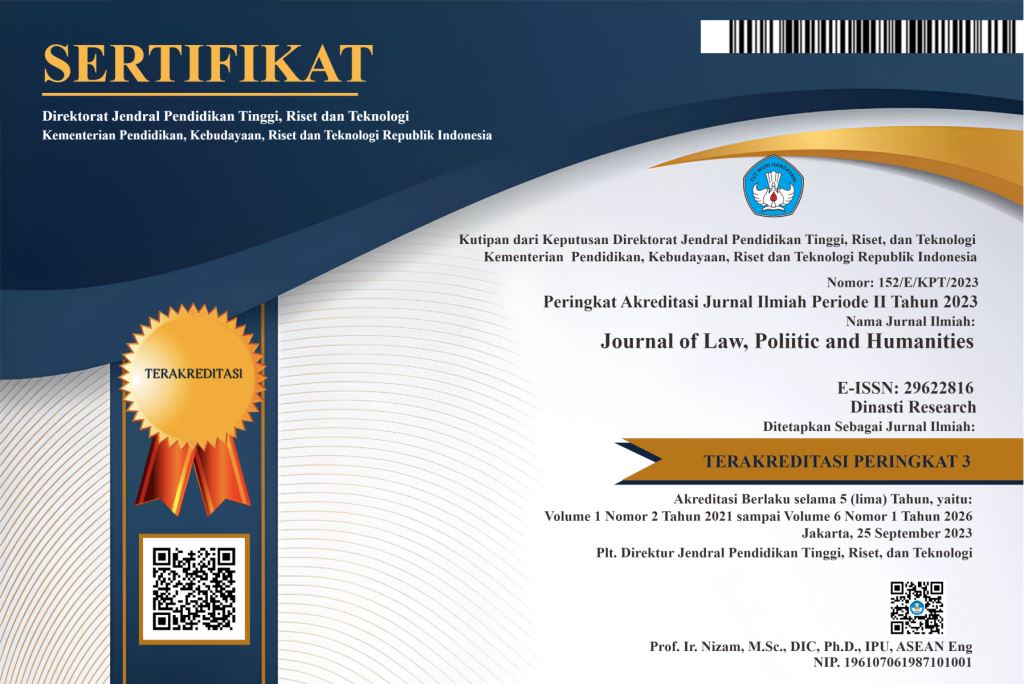Designing Effective Regulations on Rabies Control in Tropical Regions: A Systematic Literature Review
DOI:
https://doi.org/10.38035/jlph.v5i2.1140Keywords:
Rabies Control, Rabies Regulations, Tropical RegionsAbstract
Rabies, a global public health issue with a 100% mortality rate, affects tens of thousands annually, primarily in tropical regions, and is widespread in over 150 regions. Effective rabies control regulations are crucial in tropical regions due to limited healthcare, dense population, and virus-carrying species, promoting well-being, reducing costs, and promoting sustainability. This article aims to design effective regulations on rabies control in tropical regions. The study utilized a systematic literature review to explore effective rabies control in tropical regions. The analysis used Publish and Perish 8 tool and Mendeley Reference Manager software. The PRISMA was employed to guide the investigation. The study identified 26 significant research articles from 357 exclusions. The results reveal that pet rabies regulations may not effectively control outbreaks, requiring prioritizing awareness campaigns due to resource constraints, weak healthcare systems, and cultural factors in tropical regions. Therefore, the design of effective regulations on rabies control in tropical regions highlight: vaccination programs targeting pet domestications; reducing risk of rabies transmission through domesticated livestock; including rules on control, risk regulation, and animal population control; outlining minimum standards for health facilities and veterinary services; retraining healthcare workers and veterinarians involved in rabies prevention is necessary.
References
Abdulazeez, M., Kia, G. S. N., Abarshi, M. M., Muhammad, A., Ojedapo, C. E., Atawodi, J. C., Dantong, D., & Kwaga, J. K. P. (2020). Induction of rabies virus infection in mice brain may up and down regulate type II interferon gamma via epigenetic modifications. Metabolic Brain Disease, 35(5), 819–827. https://doi.org/10.1007/s11011-020-00553-y
Acharya, K. P., Acharya, N., Phuyal, S., Upadhyaya, M., & Lasee, S. (2020). One-health approach: A best possible way to control rabies. One Health, 10, 100161. https://doi.org/https://doi.org/10.1016/j.onehlt.2020.100161
Acharya, K. P., Subedi, D., & Wilson, R. T. (2021). Rabies control in South Asia requires a One Health approach. One Health, 12, 100215. https://doi.org/https://doi.org/10.1016/j.onehlt.2021.100215
African Health Organisation. (2020). Rabies is a zoonosis (a disease that is transmitted from animals to humans) that is caused by a virus. Rabies. https://aho.org/health-topics/rabies/
Ahmad, W., Naeem, M. A., Akram, Q., Ahmad, S., & Younus, M. (2021). Exploring rabies endemicity in Pakistan: Major constraints & possible solutions. Acta Tropica, 221, 106011. https://doi.org/https://doi.org/10.1016/j.actatropica.2021.106011
Andriamandimby, S. F., Volasoa, M. H., Razafindraibe, N. P., Ranoaritiana, D. B., Razafindramparany, M. H., Rafisandratantsoa, T., Nomenjanahary, L. A., Rakotondrabe, N., Andriamananjara, M. A., Guis, H., Lacoste, V., & Dreyfus, A. (2023). Rabies surveillance in Madagascar from 2011 to 2021: can we reach the target? Frontiers in Veterinary Science, 10. https://www.frontiersin.org/journals/veterinary-science/articles/10.3389/fvets.2023.1270532
Arias Caicedo, M. R., Xavier, D. de A., Arias Caicedo, C. A., Andrade, E., & Abel, I. (2019). Epidemiological scenarios for human rabies exposure notified in Colombia during ten years: A challenge to implement surveillance actions with a differential approach on vulnerable populations. PLOS ONE, 14(12), e0213120. https://doi.org/10.1371/journal.pone.0213120
Bahiru, A., Molla, W., Yizengaw, L., Mekonnen, S. A., & Jemberu, W. T. (2022). Knowledge, attitude and practice related to rabies among residents of Amhara region, Ethiopia. Heliyon, 8(11). https://doi.org/10.1016/j.heliyon.2022.e11366
Briceño-Loaiza, C., Fernández-Sanhueza, B., Benavides-Silva, C., Jimenez, J. Y., Rubio, A. V, Ábalos, P., & Alegría-Morán, R. A. (2024). Spatial clusters, temporal behavior, and risk factors analysis of rabies in livestock in Ecuador. Preventive Veterinary Medicine, 226, 106188. https://doi.org/10.1016/j.prevetmed.2024.106188
Bucher, A., Dimov, A., Fink, G., Chitnis, N., Bonfoh, B., & Zinsstag, J. (2023). Benefit-cost analysis of coordinated strategies for control of rabies in Africa. Nature Communications, 14(1), 5370. https://doi.org/10.1038/s41467-023-41110-2
Capps, B. (2024). One Health Environmentalism. Cambridge University Press. https://doi.org/DOI: 10.1017/9781009271097
Dizon, T. J. R., Saito, N., Inobaya, M., Tan, A., Reñosa, M. D. C., Bravo, T. A., Endoma, V., Silvestre, C., Salunga, M. A. O., Lacanilao, P. M. T., Guevarra, J. R., Kamiya, Y., Lagayan, M. G. O., Kimitsuki, K., Nishizono, A., & Quiambao, B. P. (2022). Household survey on owned dog population and rabies knowledge in selected municipalities in Bulacan, Philippines: A cross-sectional study. PLoS Neglected Tropical Diseases, 16(1), e0009948. https://doi.org/10.1371/journal.pntd.0009948
Dorji, T., Lamichaney, J., Gyaltshen, C., Lungten, L., Dhakal, G. P., Dorjee, S., & Mynak, M. L. (2023). Human rabies encephalomyelitis in the background of rabies outbreak in animals in Gelephu, Bhutan, 2023: a case report. Infectious Diseases of Poverty, 12(1), 94. https://doi.org/10.1186/s40249-023-01148-2
Duarte, N. F. H., Pires Neto, R. da J., Viana, V. F., Feijão, L. X., Alencar, C. H., & Heukelbach, J. (2021). Clinical aspects of human rabies in the state of Ceará, Brazil: an overview of 63 cases. In Revista da Sociedade Brasileira de Medicina Tropical (Vol. 54). scielo .
Gundamaraju, R., Vemuri, R. C., Sau Kuen, L., Manikam, R., Singla, R. K., Sekaran, S. D., & Chakrapani, R. (2015). The science of rabies in tropical regions: From epidemiological pandemonium to prevention. Frontiers in Life Science, 8(3), 210–214. https://doi.org/10.1080/21553769.2015.1041186
Haselbeck, A. H., Rietmann, S., Tadesse, B. T., Kling, K., Kaschubat-Dieudonné, M. E., Marks, F., Wetzker, W., & Thöne-Reineke, C. (2021). Challenges to the fight against rabies—the landscape of policy and prevention strategies in Africa. In International Journal of Environmental Research and Public Health (Vol. 18, Issue 4). https://doi.org/10.3390/ijerph18041736
Hueffer, K. (2024). Rabies Management in the North, A One Health Problem in a Systems Theory Framework [University of Alaska Fairbanks]. https://www.proquest.com/openview/a0fae721a6b2c479ee73c78861b1ac63/1?pq-origsite=gscholar&cbl=18750&diss=y
Jane Ling, M. Y., Halim, A. F. N. A., Ahmad, D., Ramly, N., Hassan, M. R., Syed Abdul Rahim, S. S., Saffree Jeffree, M., Omar, A., & Hidrus, A. (2023). Rabies in Southeast Asia: a systematic review of its incidence, risk factors and mortality. BMJ Open, 13(5), e066587. https://doi.org/10.1136/bmjopen-2022-066587
Jeon, S., Cleaton, J., Meltzer, M. I., Kahn, E. B., Pieracci, E. G., Blanton, J. D., & Wallace, R. (2019). Determining the post-elimination level of vaccination needed to prevent re-establishment of dog rabies. PLOS Neglected Tropical Diseases, 13(12), e0007869. https://doi.org/10.1371/journal.pntd.0007869
Jiang, X., Li, J., Pan, J., Cheng, L., Jiang, C., & Wang, R. (2024). The epidemiology and clinical features of post-exposure prophylaxis for rabies: A retrospective study of 9772 cases. In One health (Amsterdam, Netherlands) (Vol. 18, p. 100743). https://doi.org/10.1016/j.onehlt.2024.100743
Kisaka, S., Makumbi, F. E., Majalija, S., Bangirana, A., & Thumbi, S. M. (2020). Epidemiology and preclinical management of dog bites among humans in Wakiso and Kampala districts, Uganda: Implications for prevention of dog bites and rabies. PLOS ONE, 15(9), e0239090. https://doi.org/10.1371/journal.pone.0239090
Kotzé, J. L., Duncan Grewar, J., & Anderson, A. (2021). Modelling the factors affecting the probability for local rabies elimination by strategic control. PLOS Neglected Tropical Diseases, 15(3), e0009236. https://doi.org/10.1371/journal.pntd.0009236
Leblanc, C., Kassié, D., Ranaivoharimina, M., Rakotomanana, E. F. N., Mangahasimbola, R. T., Randrianarijaona, A., Ramiandrasoa, R., Nely, A. J., Razafindraibe, N. P., Andriamandimby, S. F., Ranoaritiana, D. B., Rajaonarivony, V., Randrianasolo, L., Baril, L., Mattern, C., Ratovoson, R., & Guis, H. (2024). Mixed methods to evaluate knowledge, attitudes and practices (KAP) towards rabies in central and remote communities of Moramanga district, Madagascar. PLOS Neglected Tropical Diseases, 18(3), e0012064. https://doi.org/10.1371/journal.pntd.0012064
Léchenne, M., Tenzin, T., Miranda, M. E., & Zinsstag, J. (2019). Rabies in East and Southeast Asia: A Mirror of the Global Situation. In J. Utzinger, P. Yap, M. Bratschi, & P. Steinmann (Eds.), Neglected Tropical Diseases - East Asia (pp. 105–127). Springer International Publishing. https://doi.org/10.1007/978-3-030-12008-5_6
León, B., González, S. F., Solís, L. M., Ramírez-Cardoce, M., Moreira-Soto, A., Cordero-Solórzano, J. M., Hutter, S. E., González-Barrientos, R., & Rupprecht, C. E. (2021). Rabies in Costa Rica - next steps towards controlling bat-borne rabies after its elimination in dogs. The Yale Journal of Biology and Medicine, 94(2), 311–329.
Mauldin, M. R., McCollum, A. M., Nakazawa, Y. J., Mandra, A., Whitehouse, E. R., Davidson, W., Zhao, H., Gao, J., Li, Y., Doty, J., Yinka-Ogunleye, A., Akinpelu, A., Aruna, O., Naidoo, D., Lewandowski, K., Afrough, B., Graham, V., Aarons, E., Hewson, R., … Reynolds, M. G. (2022). Exportation of monkeypox virus from the African continent. The Journal of Infectious Diseases, 225(8), 1367–1376. https://doi.org/10.1093/infdis/jiaa559
Miranda, M. E. G., & Miranda, N. L. J. (2020). Rabies Prevention in Asia: Institutionalizing Implementation Capacities. In H. C. J. Ertl (Ed.), Rabies and Rabies Vaccines (pp. 103–116). Springer International Publishing. https://doi.org/10.1007/978-3-030-21084-7_6
Moore, S. M. (2019). Rabies: Current Preventive Strategies. Veterinary Clinics: Small Animal Practice, 49(4), 629–641. https://doi.org/10.1016/j.cvsm.2019.02.014
Mshelbwala, P. P., Wangdi, K., Bunting-Graden, J. A., Bamayange, S., Adamu, A. M., Gupta, S. D., Suluku, R., Adamu, C. S., Weese, J. S., Rupprecht, C. E., & Clark, N. J. (2024). Insights into canine rabies vaccination Disparities in Sierra Leone: A cross-sectional household study. PLoS Neglected Tropical Diseases, 18(7), e0012332. https://doi.org/10.1371/journal.pntd.0012332
Mshelbwala, P. P., Weese, J. S., Clark, N. J., Tekki, I., Chakma, S., Shamaki, D., Mamun, A. A., Rupprecht, C. E., & Soares Magalhães, R. J. (2022). Spatiotemporal heterogeneity and determinants of canine rabies evidence at Local Government Area Level in Nigeria: Implications for rabies prevention and control. One Health, 14, 100378. https://doi.org/https://doi.org/10.1016/j.onehlt.2022.100378
Naïssengar, K., Oussiguere, A., Madaye, E., Mbaipago, N., Mindekem, R., Moyengar, R., Madjadinan, A., Ngandolo, R., Zinsstag, J., & Léchenne, M. (2021). Challenges to improved animal rabies surveillance: Experiences from pilot implementation of decentralized diagnostic units in Chad. Acta Tropica, 221, 105984. https://doi.org/https://doi.org/10.1016/j.actatropica.2021.105984
Naveenkumar, V., Bharathi, M. V., Kannan, P., Selvaraju, G., Vijayarani, K., Kharkwal, P., & Chanda, M. M. (2022). Temporal pattern and risk factors for occurrence of Canine Rabies in Chennai. Comparative Immunology, Microbiology and Infectious Diseases, 90–91, 101903. https://doi.org/https://doi.org/10.1016/j.cimid.2022.101903
Nayak, J. B., Chaudhary, J. H., Bhavsar, P. P., Anjaria, P. A., Brahmbhatt, M. N., & Mistry, U. P. (2022). Rabies: Incurable Biological Threat. In G. Bastidas (Ed.), Zoonosis of Public Health Interest (p. Ch. 3). IntechOpen. https://doi.org/10.5772/intechopen.105079
Neevel, A. M. G., Urias, E., Claassen, E., & van de Burgwal, L. H. M. (2020). Quantity vs. quality: an assessment of the current pipeline for rabies. Tropical Medicine & International Health, 25(4), 397–407. https://doi.org/10.1111/tmi.13367
Nyasulu, P. S., Weyer, J., Tschopp, R., Mihret, A., Aseffa, A., Nuvor, S. V., Tamuzi, J. L., Nyakarahuka, L., Helegbe, G. K., Ntinginya, N. E., Gebreyesus, M. T., Doumbia, S., Busse, R., & Drosten, C. (2021). Rabies mortality and morbidity associated with animal bites in Africa: a case for integrated rabies disease surveillance, prevention and control: a scoping review. BMJ Open, 11(12), e048551. https://doi.org/10.1136/bmjopen-2020-048551
Ojedapo, C. E., Muhammad, A., Kia, G. S. N., Abarshi, M. M., Abdulazeez, M., Atawodi, J. C., & Kwaga, J. K. P. (2020). Rabies virus infection in mice up-regulates B7-H1 via epigenetic modifications. Virusdisease, 31(3), 388–394. https://doi.org/10.1007/s13337-020-00588-w
Penjor, K., Tenzin, T., & Jamtsho, R. K. (2019). Determinants of health seeking behavior of animal bite victims in rabies endemic South Bhutan: a community-based contact-tracing survey. BMC Public Health, 19(1), 237. https://doi.org/10.1186/s12889-019-6559-x
Pham, Q. D., Phan, L. T., Nguyen, T. P. T., Doan, Q. M. N., Nguyen, H. D., Luong, Q. C., & Nguyen, T. V. (2021). An evaluation of the rabies surveillance in Southern Vietnam. Frontiers in Public Health, 9. https://www.frontiersin.org/journals/public-health/articles/10.3389/fpubh.2021.610905
Prasanjaya, P. N. K., Tosepu, R., & Rizqiyah, N. (2020). The influence of public awareness on prevention of rabies cases in several Asian countries: A review. IOP Conference Series: Earth and Environmental Science, 465(1), 12007. https://doi.org/10.1088/1755-1315/465/1/012007
Public Health of England. (2019). Rabies?: epidemiology , transmission and prevention. https://www.gov.uk/guidance/rabies-epidemiology-transmission-and-prevention
Quiambao, B., Varghese, L., Demarteau, N., Sengson, R. F., Javier, J., Mukherjee, P., Manio, L. C., & Preiss, S. (2020). Health economic assessment of a rabies pre-exposure prophylaxis program compared with post-exposure prophylaxis alone in high-risk age groups in the Philippines. International Journal of Infectious Diseases, 97, 38–46. https://doi.org/https://doi.org/10.1016/j.ijid.2020.05.062
Raynor, B. (2023). Epidemiology and Control of Canine Rabies in Heterogeneous Populations [University of Pennsylvania]. https://www.proquest.com/openview/429c3c7fb7a2231fc82bb2ec0db17114/1?pq-origsite=gscholar&cbl=18750&diss=y
Rohde, R. E., & Rupprecht, C. E. (2020). Update on lyssaviruses and rabies: will past progress play as prologue in the near term towards future elimination? Faculty Reviews, 9, 9. https://doi.org/10.12703/b/9-9
Rupprecht, C. E., Abela-Ridder, B., Abila, R., Amparo, A. C., Banyard, A., Blanton, J., Chanachai, K., Dallmeier, K., de Balogh, K., Del Rio Vilas, V., Ertl, H., Freuling, C., Hill, R., Houillon, G., Jakava-Viljanen, M., Kasemsuwan, S., Léchenet, J., Nel, L., Panichabhongse, P., … Mueller, T. (2020). Towards rabies elimination in the Asia-Pacific region: From theory to practice. Biologicals, 64, 83–95. https://doi.org/https://doi.org/10.1016/j.biologicals.2020.01.008
Rupprecht, C. E., Mshelbwala, P. P., Reeves, R. G., & Kuzmin, I. V. (2023). Rabies in a postpandemic world: resilient reservoirs, redoubtable riposte, recurrent roadblocks, and resolute recidivism. Animal Diseases, 3(1), 15. https://doi.org/10.1186/s44149-023-00078-8
Rupprecht, C. E., & Salahuddin, N. (2019). Current status of human rabies prevention: remaining barriers to global biologics accessibility and disease elimination. Expert Review of Vaccines, 18(6), 629–640. https://doi.org/10.1080/14760584.2019.1627205
Schreuder, I., De Pijper, C., van Kessel, R., Visser, L., & van den Kerkhof, H. (2020). Abandon of intramuscular administration of rabies immunoglobulin for post-exposure prophylaxis in the revised guidelines in the Netherlands in 2018: cost and volume savings. Euro Surveillance?: Bulletin Europeen Sur Les Maladies Transmissibles = European Communicable Disease Bulletin, 25(38). https://doi.org/10.2807/1560-7917.ES.2020.25.38.2000018
South Carolina Department of Health and Environmental Control. (2019). Rabies Control Act. Law and Regulations. https://scdhec.gov/laws-regulations/rabies-control-act
Subedi, D., Chandran, D., Subedi, S., & Acharya, K. P. (2022). Ecological and socioeconomic factors in the occurrence of rabies: A forgotten scenario. In Infectious Disease Reports (Vol. 14, Issue 6, pp. 979–986). https://doi.org/10.3390/idr14060097
Swedberg, C., Mazeri, S., Mellanby, R. J., Hampson, K., & Chng, N. R. (2022). Implementing a One Health approach to rabies surveillance: Lessons from integrated bite case management. Frontiers in Tropical Diseases, 3. https://www.frontiersin.org/journals/tropical-diseases/articles/10.3389/fitd.2022.829132
Tasiame, W., El-Duah, P., Johnson, S. A. M., Owiredu, E.-W., Bleicker, T., Veith, T., Schneider, J., Emikpe, B., Folitse, R. D., Burimuah, V., Akyereko, E., Drosten, C., & Corman, V. M. (2022). Rabies virus in slaughtered dogs for meat consumption in Ghana: A potential risk for rabies transmission. Transboundary and Emerging Diseases, 69(4), e71–e81. https://doi.org/10.1111/tbed.14266
Tasmanian Department of Health. (2024). Rabies and Australian Bat Lyssavirus. https://www.health.tas.gov.au/rabies-and-australian-bat-lyssavirus
Thiel, A. (2024). Health-in-all, Data Harmonisation, and Cross-sectoral Collaboration in Ghana’s Health Sector. In A. Thiel & S. A. Ntewusu (Eds.), The Social Life of Health Data: Health Records and Knowledge Production in Ghana (pp. 143–166). Springer Nature Singapore. https://doi.org/10.1007/978-981-97-3500-6_7
Tiwari, H. K., Gogoi-Tiwari, J., & Robertson, I. D. (2021). Eliminating dog-mediated rabies: challenges and strategies. Animal Diseases, 1(1), 19. https://doi.org/10.1186/s44149-021-00023-7
Tu, S., Sun, F. Y., Chantler, T., Zhang, X., Jit, M., Han, K., Rodewald, L., Du, F., Yu, H., Hou, Z., & Larson, H. (2020). Caregiver and service provider vaccine confidence following the Changchun Changsheng vaccine incident in China: A cross-sectional mixed methods study. Vaccine, 38(44), 6882–6888. https://doi.org/10.1016/j.vaccine.2020.08.063
WHO Rabies Modelling Consortium. (2019). Zero human deaths from dog-mediated rabies by 2030: perspectives from quantitative and mathematical modelling. Gates Open Research, 3, 1564. https://doi.org/10.12688/gatesopenres.13074.2
Williams, D. J., Faiz, M. A., Abela-Ridder, B., Ainsworth, S., Bulfone, T. C., Nickerson, A. D., Habib, A. G., Junghanss, T., Fan, H. W., Turner, M., Harrison, R. A., & Warrell, D. A. (2019). Strategy for a globally coordinated response to a priority neglected tropical disease: Snakebite envenoming. PLOS Neglected Tropical Diseases, 13(2), e0007059. https://doi.org/10.1371/journal.pntd.0007059
World Health Organization. (2024). Rabies. Newsroom. https://www.who.int/news-room/fact-sheets/detail/rabies/?gad_source=1&gclid=CjwKCAjwodC2BhAHEiwAE67hJIBtJaFos4bgDD6Z1rw3wst4GcHs2dOEVUrcW4mYuXeUmMxerLFfMRoCuaAQAvD_BwE
Yasobant, S., Bruchhausen, W., Saxena, D., & Falkenberg, T. (2019). One health collaboration for a resilient health system in India: Learnings from global initiatives. One Health, 8, 100096. https://doi.org/https://doi.org/10.1016/j.onehlt.2019.100096
Downloads
Published
How to Cite
Issue
Section
License
Copyright (c) 2024 Ni Putu Meiliana Dewantari, I Nyoman Bagiastra, I Wayan Gede Artawan Eka Putra

This work is licensed under a Creative Commons Attribution 4.0 International License.
Authors who publish their manuscripts in this journal agree to the following conditions:
- The copyright on each article belongs to the author(s).
- The author acknowledges that the Journal of Law, Poliitic and Humanities (JLPH) has the right to be the first to publish with a Creative Commons Attribution 4.0 International license (Attribution 4.0 International (CC BY 4.0).
- Authors can submit articles separately, arrange for the non-exclusive distribution of manuscripts that have been published in this journal into other versions (e.g., sent to the author's institutional repository, publication into books, etc.), by acknowledging that the manuscript has been published for the first time in the Journal of Law, Poliitic and Humanities (JLPH).


























